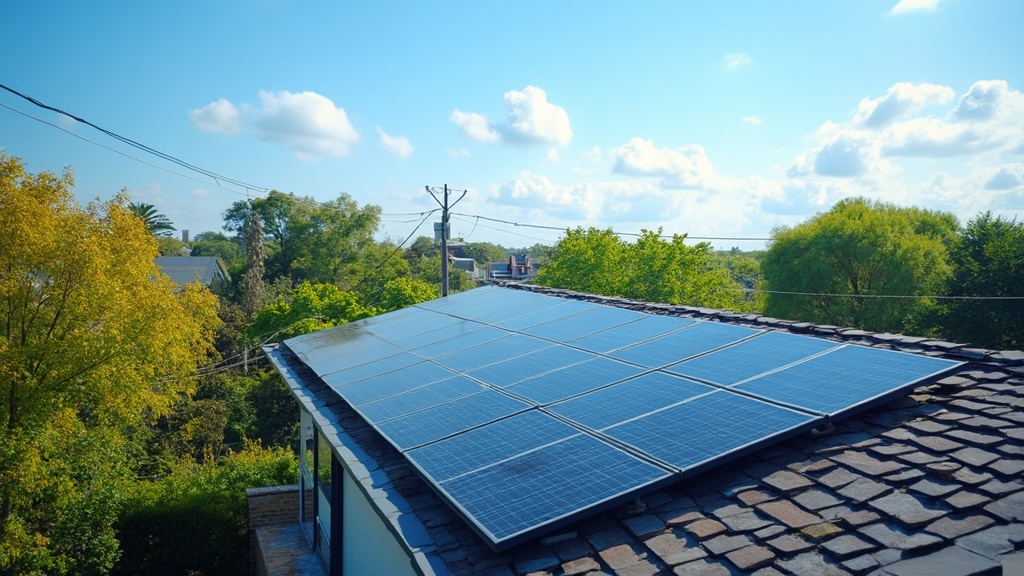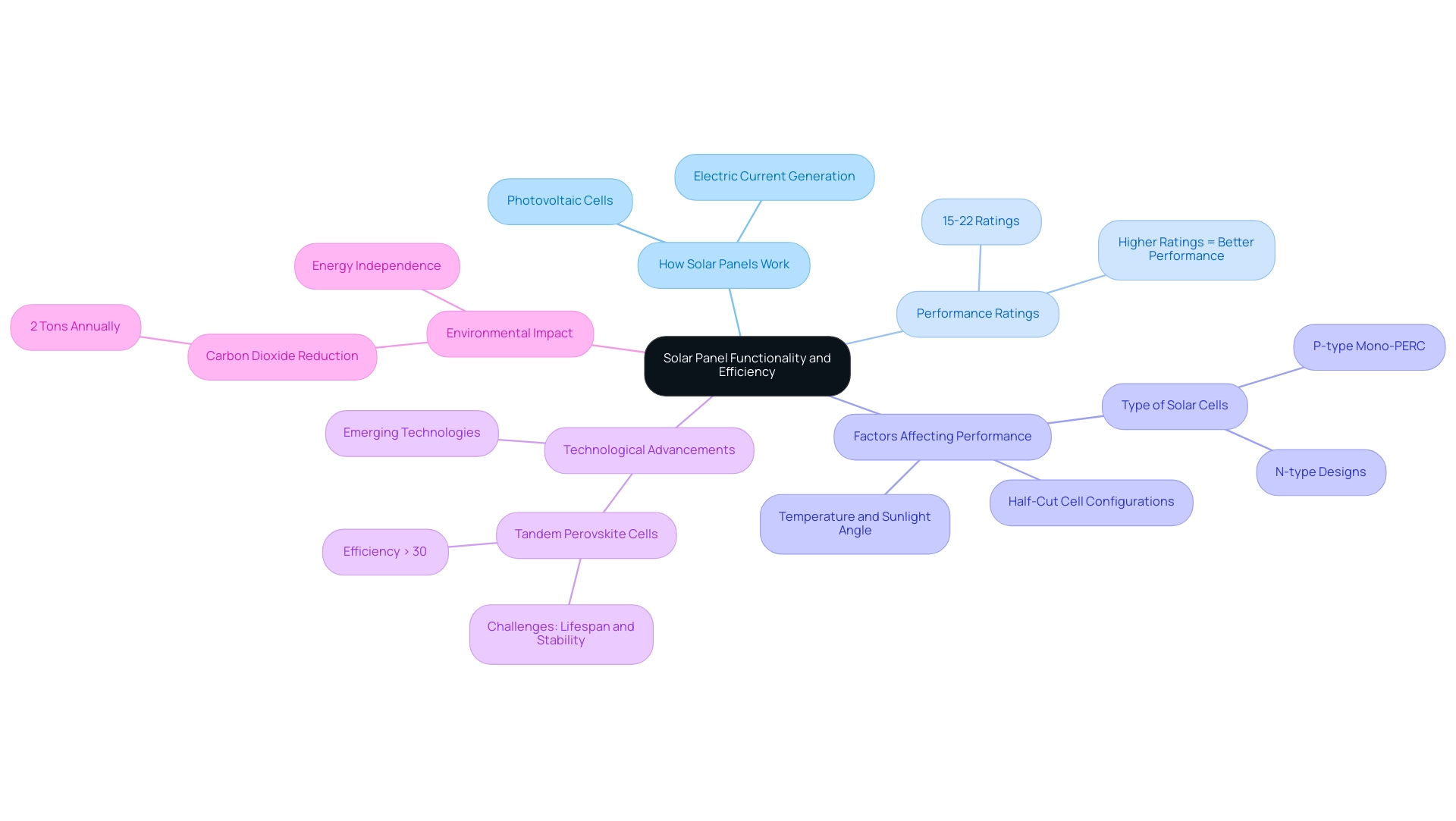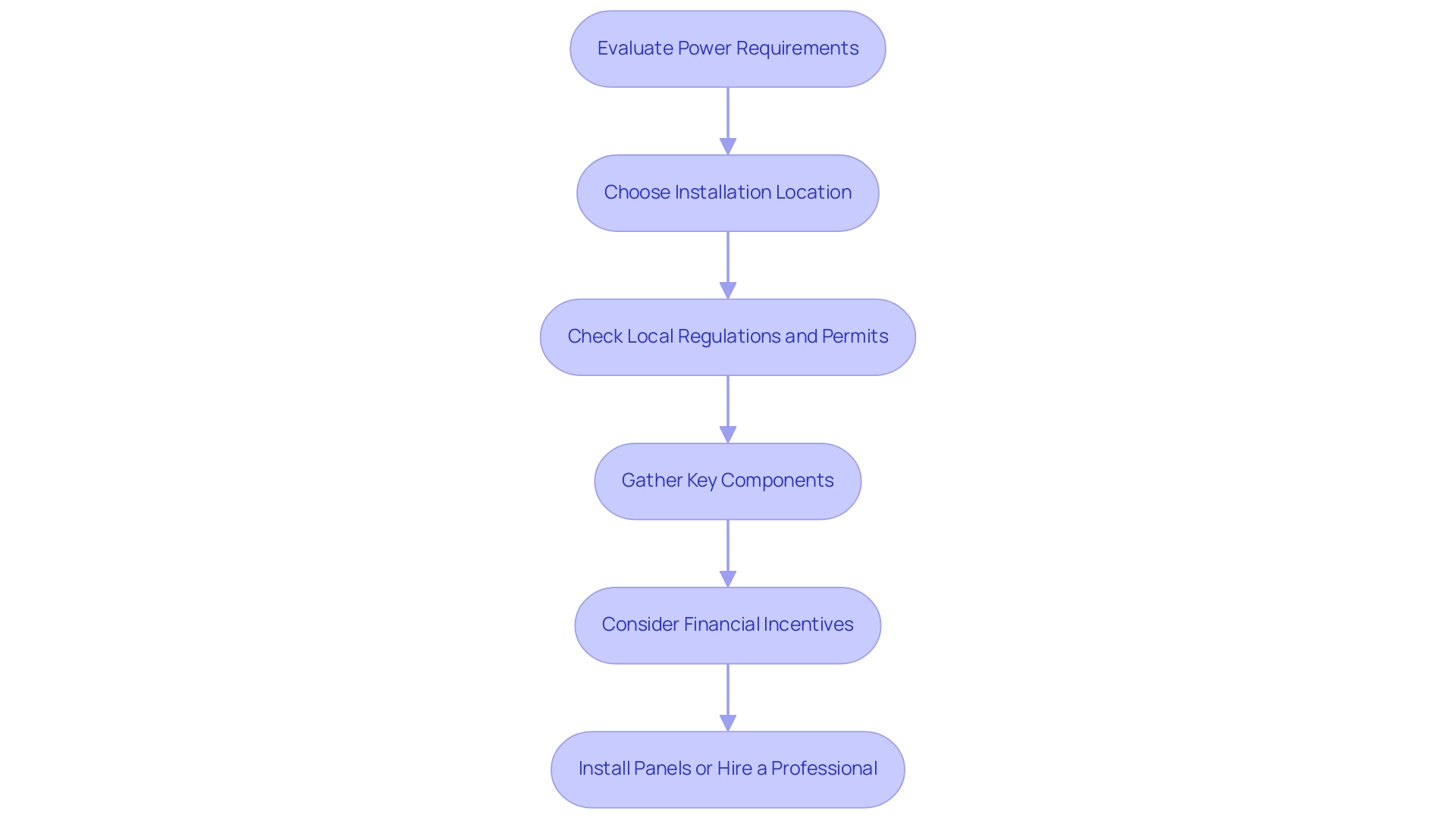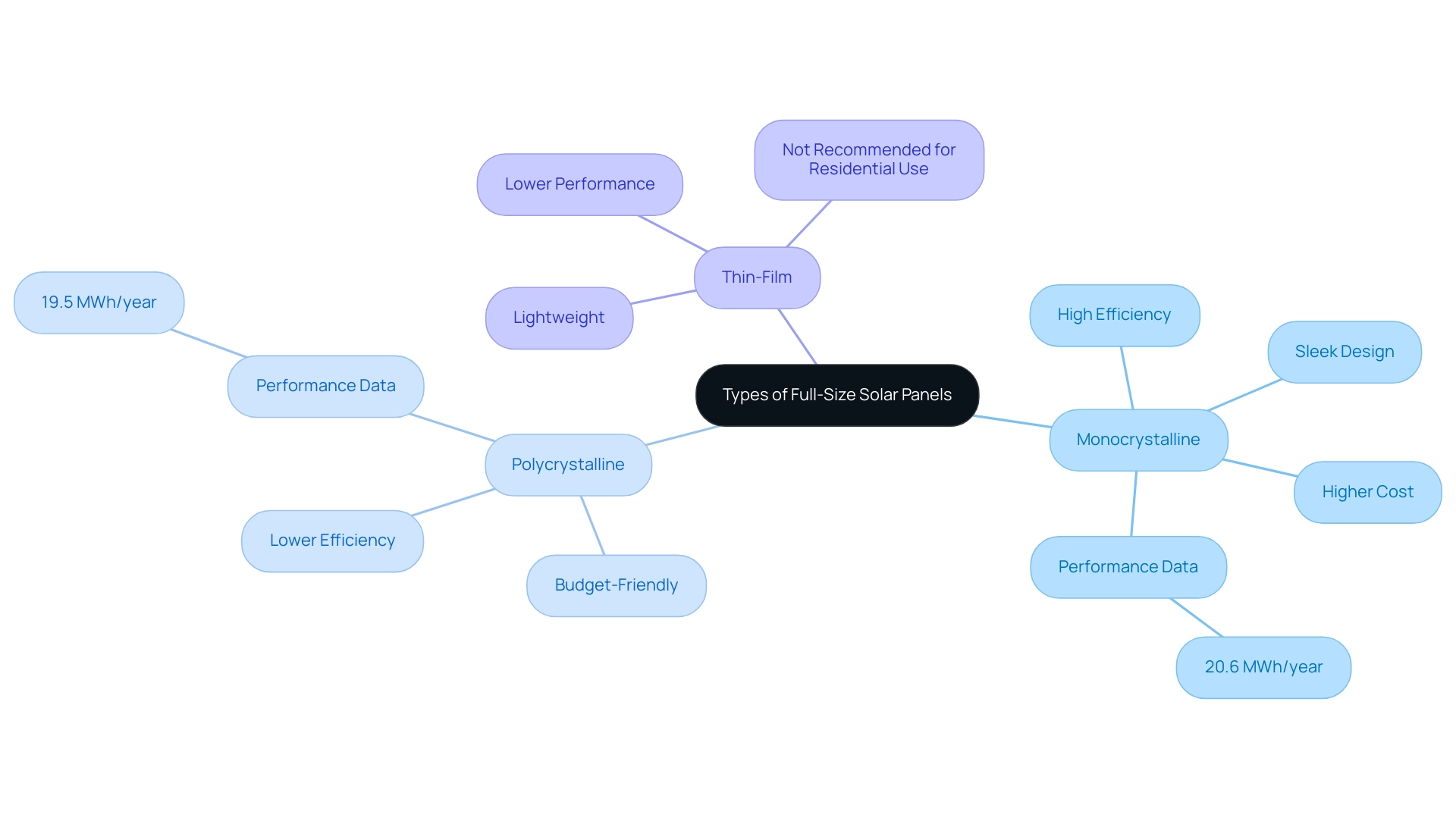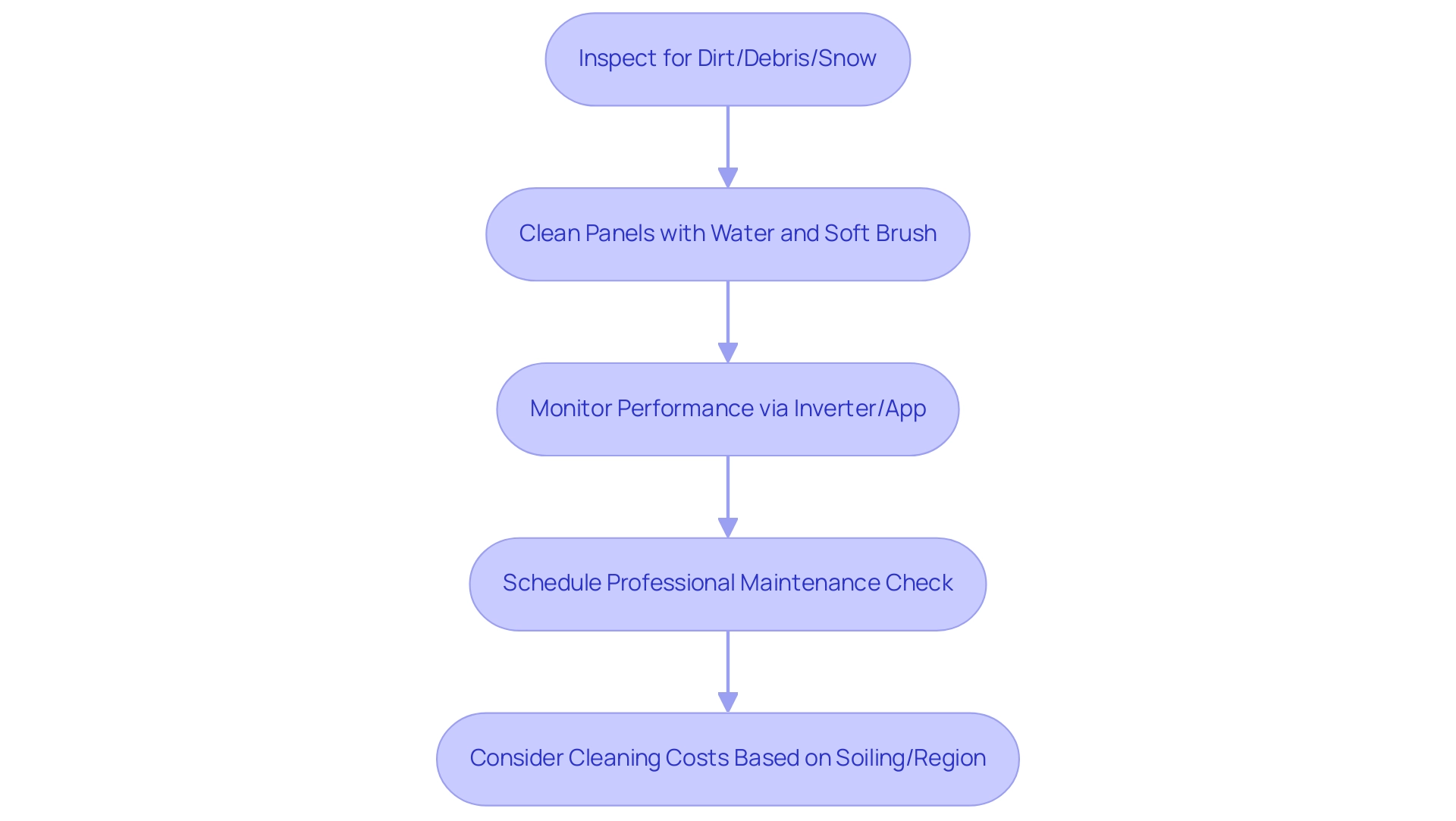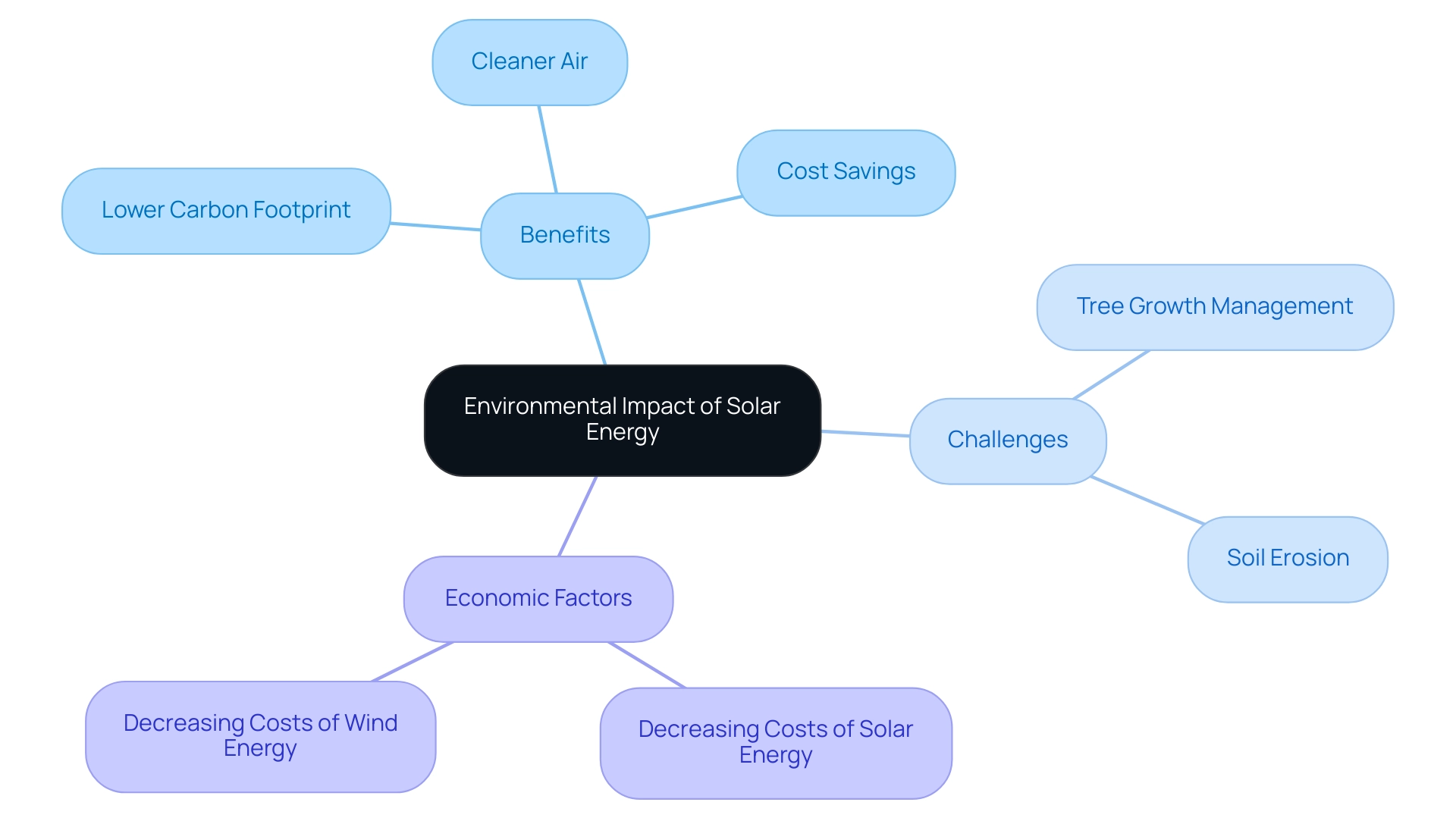Overview
Full-size solar panels are vital for sustainable energy solutions, effectively converting sunlight into electricity and significantly reducing carbon footprints while offering long-term savings on utility costs. The article emphasizes the importance of understanding solar panel efficiency, installation processes, and available incentives, which collectively guide homeowners in making informed decisions that enhance both energy independence and environmental health.
Introduction
With the sun shining brighter than ever on the renewable energy landscape, homeowners are increasingly turning to solar panels as a sustainable solution for their energy needs. But what exactly goes into harnessing this abundant natural resource?
From understanding how solar panels convert sunlight into electricity to selecting the right type for your home, there’s a wealth of information to navigate. This article serves as a comprehensive guide for homeowners looking to make informed decisions about solar energy. It covers everything from the functionality and efficiency of solar panels to the incentives available for installation, ensuring that readers are equipped with the knowledge they need to embrace this eco-friendly technology.
As the world shifts towards cleaner energy sources, exploring the ins and outs of solar power could not only save money but also contribute to a healthier planet.
Understanding Solar Panel Functionality and Efficiency
Solar modules work their magic by converting sunlight into electricity using photovoltaic (PV) cells. When the sun rays hit the cells, they kickstart an electric current that can power your home, making the most of our abundant natural resource. The performance of a photovoltaic panel indicates how effectively it converts sunlight into usable electricity, with contemporary panels usually showcasing performance ratings ranging from 15% to 22%.
Higher ratings mean better performance, which is great news for your energy savings! Numerous factors affect this performance, including the type of solar cells utilized—did you know that major manufacturers are now transitioning from lower-cost P-type mono-PERC cells to the more effective N-type designs? Additionally, half-cut cell configurations are gaining popularity due to their increased efficiency, resulting from lower resistive losses and a lower temperature coefficient.
Temperature also plays a role, as does the angle at which sunlight strikes the surfaces. Comprehending these elements is crucial when selecting the best panels for your home. Choosing for greater performance alternatives can result in substantial savings over time, possibly saving you hundreds of dollars each year on your utility expenses.
As Jason Svarc, an accredited energy and battery specialist, highlights, staying informed about these advancements is key to making the right choice for your energy needs. Furthermore, with the residential solar market expected to expand by 14% in 2025, the significance of solar panel performance becomes even more evident. Technologies like Tandem Perovskite cells are emerging, demonstrating performance surpassing 30% in testing, although challenges such as reduced lifespan remain.
Moreover, considering thermal performance ratings is crucial, as they measure how effectively a system converts sunlight into usable heat. For water heating systems, the output compared to input is essential in assessing overall efficiency. Embracing these innovative technologies not only supports your energy independence but also contributes to a healthier planet by reducing reliance on conventional energy sources.
In fact, utilizing heating systems powered by the sun can prevent around 2 tons of carbon dioxide from entering the atmosphere each year, equivalent to not operating a vehicle for four months. This progressive viewpoint on renewable energy advancements further highlights the importance of informed decision-making for homeowners contemplating energy system options.
A Comprehensive Guide to Installing Full-Size Solar Panels
Installing a full size solar panel is an exciting step towards sustainable living! Start by evaluating your power requirements, which can be easily accomplished by examining your electricity bills to determine your average usage. This is crucial since, notably, merely one hour of midday summer sunlight can generate sufficient power to satisfy the yearly electricity requirements of the whole U.S.
Considering your power needs, reflect on where you will install those modules. For optimal energy production, aim for a south-facing roof that enjoys minimal shading from trees or neighboring buildings. Don’t forget to check your local regulations and obtain any necessary permits before installation—this can save you from potential headaches down the line.
As you prepare, consider the key components you’ll need:
- Full size solar panels
- Mounting hardware
- An inverter to convert the direct current (DC) electricity to alternating current (AC)
- A monitoring system to track the performance of your system
Additionally, explore government programs for panels, such as the federal investment tax credit (ITC) and state-specific incentives, which can provide financial support and make this transition more affordable for homeowners. If the thought of a DAY installation feels daunting, don’t worry!
Hiring a professional installer can ensure everything is set up safely and correctly. Keep in mind, a proper installation is essential for maximizing both your savings and efficiency—after all, you’ll want to make the most out of your investment in clean power!
Moreover, as the global manufacturing capacity of photovoltaic systems is projected to reach nearly 1,000 GW in 2024, it’s clear that renewable power is becoming increasingly vital in our pursuit of sustainability. As Cristen Hemingway Jaynes pointed out, environmental initiatives such as Thailand’s prohibition on plastic waste imports emphasize the worldwide shift towards decreasing pollution and adopting cleaner power sources. Furthermore, significant U.S. companies, such as Meta, Amazon, Google, Apple, and Walmart, are investing in photovoltaic systems and storage at unparalleled levels, demonstrating successful panel installations and the increasing trend of corporate investment in sustainable resources.
Don’t forget to consider battery options for energy storage, such as lithium-ion or lead-acid batteries, allowing you to harness energy even when the sun isn’t shining! This is especially important for Long Beach renters who may encounter unique challenges in obtaining sustainable energy solutions.
Selecting the Right Type of Full-Size Solar Panels
When selecting a full size solar panel for your home, you should consider three primary types: monocrystalline, polycrystalline, and thin-film. Monocrystalline modules are renowned for their high performance and sleek, space-saving design, although they generally come with a higher cost. In fact, data indicates that in fixed orientations, monocrystalline cells can produce around 20.6 MWh per year, outperforming polycrystalline cells, which generate approximately 19.5 MWh per year.
Both varieties of modules are designed to produce electricity efficiently for 25 years or more, reinforcing their long-term value. This efficiency often translates into better long-term savings, making them a worthwhile investment for many homeowners. The narrowing price gap between monocrystalline and polycrystalline options has led more homeowners to choose monocrystalline for better efficiency.
On the other hand, polycrystalline alternatives, while generally less efficient, offer a more budget-friendly choice. They can be an appealing option for those seeking to utilize sunlight without exceeding their budget, particularly when taking into account the different governmental initiatives available to support homeowners in making the transition, as mentioned in our article ‘How Homeowners Can Benefit from Government Solar Panels Program.’ Thin-film modules, recognized for their lightweight and adaptable characteristics, can fit into unconventional spaces; however, they often come with lower performance ratings and are not typically recommended for residential installations due to concerns about effectiveness and durability.
When choosing the appropriate type for your home, it’s essential to evaluate your roof size, budget, and energy requirements carefully. As noted in the case study titled ‘Best Type of Solar Module for Your Home,’ monocrystalline systems are recommended for residential installations, including full size solar panels, due to their subtle appearance, high efficiency, and durability, despite a higher price. Catherine Lane, a renewable energy specialist, emphasizes, ‘The brand of photovoltaic modules and the installer you select is far more significant than which type of module you set up.’
Consulting with an energy specialist can provide personalized recommendations tailored to your unique circumstances, ensuring you make an informed decision that aligns with your eco-conscious goals. Furthermore, contemplate the possible advantages of incorporating panel shingles, which can provide aesthetic benefits and enhanced efficiency, along with efficient heating systems, which can further improve your home’s sustainability, as discussed in our article ‘Exploring the Benefits and Drawbacks of Panel Shingles.
Understanding Solar Incentives and Rebates
In sunny California, eco-conscious homeowners have a fantastic opportunity to benefit from a range of energy incentives! One standout option is the federal tax credit for renewable installations, also known as the Investment Tax Credit (ITC), which allows you to deduct a generous percentage of your installation costs from your federal taxes—making your transition to this alternative power source smoother and more affordable. For example, after utilizing the 30% federal credit, a standard 5 kW panel system can cost as little as $8,087!
Moreover, many local utility companies, like the Corona Department of Water & Power, offer rebates for both residential and commercial photovoltaic (PV) systems, further easing your upfront costs. California’s Self-Generation Incentive Program (SGIP) also offers beneficial rebates for installing battery systems, improving your power storage and making photovoltaic installations even more favorable.
When comparing renewable energy to traditional electricity, homeowners can expect significant long-term savings, especially with rising electricity rates. Investing in a full size solar panel not only reduces your monthly utility expenses but can also increase your property value.
Don’t forget to investigate any state-specific programs for extra financial assistance, such as those provided by EnergySage, which includes choices for community energy and backup power solutions. It’s crucial to stay updated on these incentives, especially with upcoming adjustments in 2024 regarding the federal energy tax credit.
At Powercore Electric, we take pride in providing customized energy solutions to address the unique requirements of homeowners throughout both Northern and Southern California. Our experienced team is here to guide you through the entire installation process, ensuring you maximize your savings and benefits. As Emily Walker puts it, “Claiming the ITC is easy!
Just follow these three simple steps:
- Print out IRS form 5695,
- Fill out the form using the documentation you get from your installer,
- Submit the completed form when you file your taxes.”
This straightforward process can help you reap the full benefits of harnessing renewable energy!
Maintaining Your Solar Panel System
Maintaining your solar energy system in optimal condition is not only simple but also essential for guaranteeing it operates efficiently. Begin by regularly inspecting your surfaces for any dirt, debris, or snow that could obstruct sunlight. A gentle cleaning a few times a year using just water and a soft brush can significantly enhance your system’s efficiency.
As one expert noted, “Did you notice a significant drop in energy production? This issue can be due to a variety of factors, with the most common being the aforementioned dust and debris buildup.” Additionally, R.H. Haralson highlights effective cleaning methods, stating, “Another process described, counter-current rinsing in three tanks, cuts water usage to one-hundredth that required… with only one tank.” The TOPSIS technique has shown that manual cleaning methods rank highest among cleaning techniques, reinforcing the effectiveness of this approach.
Moreover, researchers from the Indian Institute of Engineering Science and Technology have created a model to assess dust buildup on photovoltaic surfaces, which is essential for enhancing maintenance. In warmer climates, be aware that higher temperatures can lead to increased degradation rates in your panels due to reduced airflow and negative effects on electronic performance. Monitor your system’s performance via the inverter’s display or a monitoring app; this will help you spot any significant drops in energy output that could signal underlying issues.
It’s wise to schedule a professional maintenance check every few years to catch and address potential problems early on. Remember, regular inspections and maintenance not only enhance performance but also prolong the lifespan of your energy system, maximizing your investment. It’s also important to consider that the cost of cleaning panels can vary based on the type of soiling and the region you reside in, which can influence your maintenance decisions.
For example, a recent case study on a large photovoltaic power facility in Senegal demonstrated that an optimized cleaning schedule could result in significant financial advantages and enhanced output, proving that a little maintenance goes a long way! Moreover, data indicates that the median loss rate for photovoltaic system performance is 0.75% per year, with 90% of systems encountering less than a 2% loss each year. As you investigate sunlight power alternatives, think about how Tesla home chargers and government initiatives can improve your efficiency, while also exploring dependable battery options for optimal storage.
Understanding the Environmental Impact of Solar Energy
Transitioning to renewable power is one of the most effective methods to substantially lower your carbon footprint and improve the sustainability of your home. Full size solar panels harness the sun’s abundant energy, generating clean, renewable electricity while avoiding the greenhouse gas emissions that are associated with fossil fuels. In fact, a recent surge in wind and photovoltaic power generation has helped prevent nearly 75 million tons of CO2 emissions, showcasing the direct benefits of this transition.
By opting for renewable energy, not only are you illuminating your home, but you’re also actively contributing to a cleaner environment, which means fresher air and a healthier community for everyone.
In Southern California, innovative initiatives like renewable-powered EV charging stations are on the rise, creating convenient options for eco-conscious drivers. Furthermore, choosing the appropriate roof design can enhance sunlight collection, especially in areas such as San Diego. For instance, a household in Southern California saw an impressive decrease in their utility costs, over 70%, after setting up a water warming system combined with a heat exchanger.
This setup not only provided significant savings but also contributed to their sustainability efforts by reducing their carbon footprint. However, it’s crucial to consider the environmental context surrounding renewable power. Concerns have been raised about managing tree growth around full size solar panels and the potential for erosion and soil loss, which could impact the effectiveness of these installations.
Tackling these obstacles is essential for sustainable adoption of photovoltaic systems.
Furthermore, as indicated by BNEF, the expense of capturing sunlight has decreased significantly over the last ten years, with onshore wind and utility-scale photovoltaic now at around $44 and $50 per megawatt-hour, respectively. This makes renewable energy not just an environmentally responsible choice, but an economically savvy one as well. Your choice to install full size solar panels supports the movement towards sustainable energy solutions, paving the way for future generations to enjoy a planet with cleaner air and reduced reliance on polluting energy sources.
As we move towards a more electrified future, new solutions like solar-powered EV charging will further enhance the environmental benefits of solar adoption.
Conclusion
Embracing solar energy is not just a trend; it’s a significant step toward a sustainable future for homeowners. By understanding how solar panels work, selecting the right type for specific needs, and navigating the installation process, homeowners can take full advantage of this abundant energy source. The efficiency of solar panels, influenced by technology and design, plays a crucial role in maximizing energy savings and minimizing environmental impact.
Moreover, the financial incentives available today, from federal tax credits to local rebates, make transitioning to solar energy more accessible than ever. This financial support, combined with the long-term savings on utility bills, underscores the economic benefits of investing in solar technology. Regular maintenance and upkeep are essential to ensure optimal performance, which further enhances the value of this investment.
Ultimately, choosing solar energy not only reduces personal carbon footprints but also contributes to a healthier planet. As more homeowners opt for this clean energy solution, the collective impact will drive significant changes in energy consumption patterns. With a wealth of information and resources available, now is the perfect time to explore solar options and join the movement towards a sustainable and eco-friendly lifestyle.


